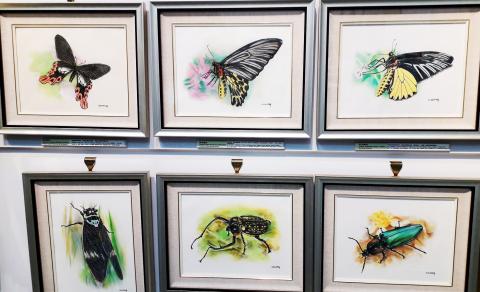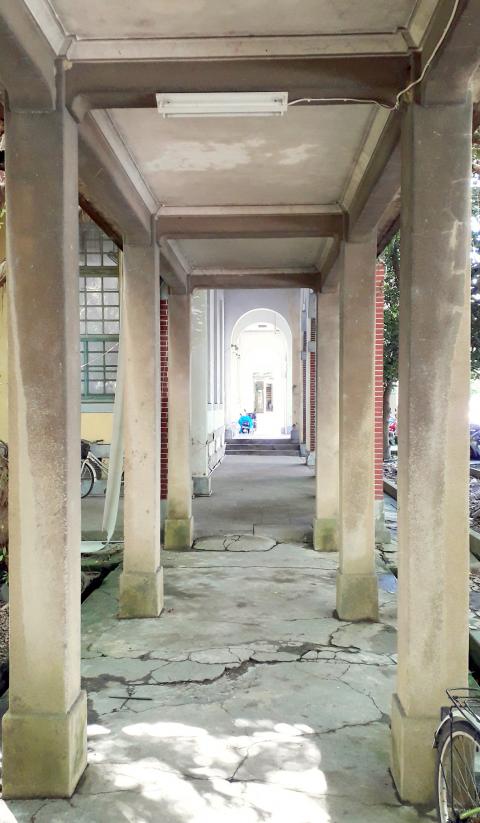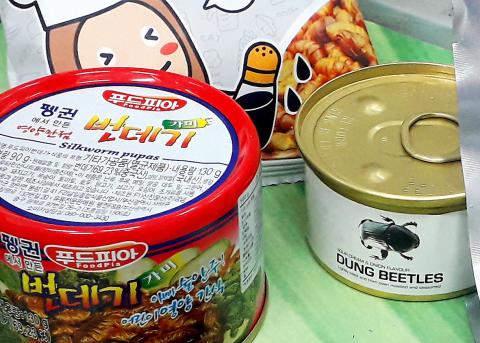Just as I was about to leave the National Taiwan University (NTU) Insect Museum (國立臺灣大學昆蟲標本館), a volunteer on duty opened an unlabeled box and invited me to touch the insects inside. The bugs, each as long as my pinky and nearly as thick as my thumb, were Madagascar hissing cockroaches. True to their name, they sibilate with displeasure when prodded. I found this fascinating — yet realize that an opportunity to engage in cockroach-petting won’t by itself get many people rushing to visit this worthwhile little museum.
The museum is probably the smallest I’ve ever visited. It’s a single room, about the size of my bedroom, augmented by a few displays in the corridor outside. I learned several things inside, and was intrigued by a few others. As a place to kill a couple of hours between meetings, it’s just about perfect.
Part of NTU’s Department of Entomology, the museum is located inside the two-story block that was purpose-built for the department around the time of its founding in 1936. The building, which is protected under Taiwan’s heritage-preservation law, retains some of its original character, but looks cramped. The corridors are filled with equipment, including ultra-low temperature freezers and temperature-controled growth chambers in which insects are reared. The latter resemble the large reach-in refrigerators found in many restaurant kitchens, but look rather more high-tech.

Photo: Steven Crook
The museum is upstairs in Room 207. Next to it, Room 205 is labeled “Insect Museum (Special Exhibition),” but only VIPs and recognized researchers are allowed inside. According to the Web site that introduces all 10 of NTU’s museums (www.museums.ntu.edu.tw), the department has a collection of 330,000 specimens, including some gathered from Taiwan’s forests and mountains before 1914.
The greater part of the collection, however, dates from after 1980, when the National Science Council (國家科學委員會; now the Ministry of Science and Technology, 科技部) began to fund comprehensive field surveys. One panel in the museum outlines the 12 methods that can be used to collect insects. Laying bait is among them; for butterflies, urine has been found to be the best.
Taiwan has around 19,000 insect species, 2 percent of the world’s total — amazing considering the island accounts for a mere 0.00024 percent of Earth’s dry land. Even now, new species are regularly identified.

Photo: Steven Crook
Among the hundreds of specimens pinned in cases outside Room 207 are some incredibly tiny creatures. The majority are labeled with their Chinese and scientific names only. I zoomed in on those whose names suggest they were unique to — or had at least been discovered in — Taiwan. One is Epilichas taiwanensis, a toe-winged beetle first described in 1996. Another is Lucanus formosanus, an endemic stag beetle which grows to a length of up to 80mm.
Phelotrupes taiwanus was described by scientists in 1995. The Chinese name translates as “black snow dung beetle” (黑雪隱金龜) and they grow up to 20mm long. If you’re willing to poke through animal droppings during the warmer months in Syuejian Forest Recreation Area (雪見森林遊憩區), they’re apparently fairly easy to find.
Also here are Opilo formosanus (a checkered beetle and an endemic, according to the Taiwan Biodiversity Information Facility: taibif.tw) and Epepeotes ambigenus formosanus. The latter is a long-horned beetle that feeds on the leaves of fig trees; it has just one close relation, in the Philippines.

Photo: Steven Crook
Not all the information in Room 207 is presented in English as well as Chinese. However, one of the more detailed bilingual panels explains the discovery of the broad-tailed swallowtail butterfly (Agehana maraho), an endemic butterfly that continues to excite researchers.
First noticed in Yilan in the 1930s, it wasn’t recognized as a species in its own right until the 21st century. Because of its wingspan (up to 10cm) and the unusual shape of its red, brown and white hindwings, it was much sought by collectors. Now listed as a protected species, it was recently determined to have descended from a North American butterfly species which made its way to East Asia between 23 million and 5.33 million years ago.
The broad-tailed swallowtail butterfly is often referred to the “national butterfly of Taiwan.” Because it subsists solely on a type of Sassafras tree found between 900 and 2,400m above sea level, few Taiwanese have been able to see it in the wild.

Photo: Steven Crook
Another panel outlines the research interests of the department’s professors, such as: conservation; insect behavior, including the dynamics of insect communities; insecticide toxicology and resistance; genetics; neurobiology (especially vision and color perception, which is important when designing yellow flypaper and other lure-and-kill devices); and insects as vectors transmitting animal and plant pathogens.
I was prepared for the silkworm pupae and crickets in the “Insects As Food” section, having sampled these delicacies in Thailand. But the can of sour-cream-and-onion-flavor dung beetles (labeled in English as well as Thai) took me by surprise. There’s no mention of the Taiwanese practice of steeping bee pupae in kaoliang liquor, a concoction which some people believe can help prevent rheumatism, gout and memory decline.
The box of purple-crow butterflies (labeled in English as well as Chinese) would be more interesting if it were accompanied by some information about these species’ remarkable migration. When the weather begins to turn cold, hundreds of thousands of Dwarf Crows, Striped Blue Crows, Double-branded Black Crows, and other butterflies fly around 250km from northern Taiwan. Many of them end up in Maolin District (茂林), where they assemble in such concentrations that this mountainous corner of Kaohsiung County is now known as the “Purple Butterfly Valley.” It’s one of the most remarkable lepidopteran gatherings in the world.
Steven Crook has been writing about travel, culture, and business in Taiwan since 1996. He is the co-author of A Culinary History of Taipei: Beyond Pork and Ponlai, and author of Taiwan: The Bradt Travel Guide, the third edition of which has just been published.

Behind a car repair business on a nondescript Thai street are the cherished pets of a rising TikTok animal influencer: two lions and a 200-kilogram lion-tiger hybrid called “Big George.” Lion ownership is legal in Thailand, and Tharnuwarht Plengkemratch is an enthusiastic advocate, posting updates on his feline companions to nearly three million followers. “They’re playful and affectionate, just like dogs or cats,” he said from inside their cage complex at his home in the northern city of Chiang Mai. Thailand’s captive lion population has exploded in recent years, with nearly 500 registered in zoos, breeding farms, petting cafes and homes. Experts warn the

The unexpected collapse of the recall campaigns is being viewed through many lenses, most of them skewed and self-absorbed. The international media unsurprisingly focuses on what they perceive as the message that Taiwanese voters were sending in the failure of the mass recall, especially to China, the US and to friendly Western nations. This made some sense prior to early last month. One of the main arguments used by recall campaigners for recalling Chinese Nationalist Party (KMT) lawmakers was that they were too pro-China, and by extension not to be trusted with defending the nation. Also by extension, that argument could be

Aug. 4 to Aug. 10 When Coca-Cola finally pushed its way into Taiwan’s market in 1968, it allegedly vowed to wipe out its major domestic rival Hey Song within five years. But Hey Song, which began as a manual operation in a family cow shed in 1925, had proven its resilience, surviving numerous setbacks — including the loss of autonomy and nearly all its assets due to the Japanese colonial government’s wartime economic policy. By the 1960s, Hey Song had risen to the top of Taiwan’s beverage industry. This success was driven not only by president Chang Wen-chi’s

Last week, on the heels of the recall election that turned out so badly for Taiwan, came the news that US President Donald Trump had blocked the transit of President William Lai (賴清德) through the US on his way to Latin America. A few days later the international media reported that in June a scheduled visit by Minister of National Defense Wellington Koo (顧立雄) for high level meetings was canceled by the US after China’s President Xi Jinping (習近平) asked Trump to curb US engagement with Taiwan during a June phone call. The cancellation of Lai’s transit was a gaudy